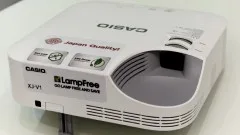We talked with Absen in detail at IBC, so there wasn’t much news for us at Infocomm. However, we hadn’t appreciated that 80% of the company’s sales are outside China. The company has been selling products in the Middle East since 2005 and is seeing around 20% growth, year on year.
We met with AFNLEDs at IFA and Gitex last year, but, this year, it skipped IFA (it told us last year that Gitex was more positive). AFNLEDs supplies LED displays for TV use – it doesn’t pitch for custom and general LED business. The Middle East and China are the firm’s best markets. At the show, it had a 2.5mm FullHD display that sells for $300,000 and is available in mass production now. A new product this year was the 1.8mm 165″ set which has a new design with a very clean back – almost no cables at all. The set uses 45 cabinets to give a native resolution of 2160 x 1080. (we couldn’t help noticing as we left the booth that all the sales staff were female).
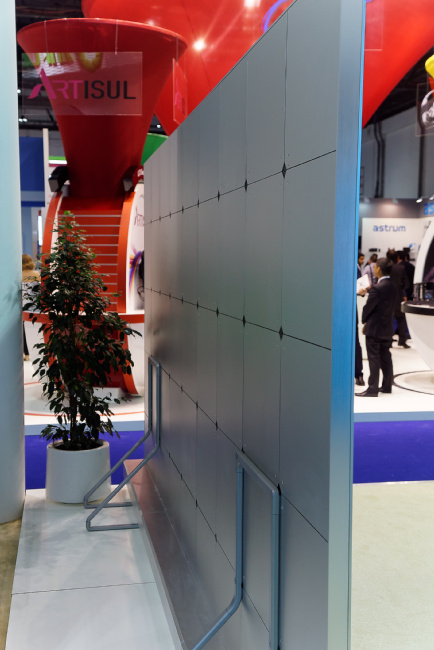 AFNLEDs displays are intended as TVs and have a very clean back surface
AFNLEDs displays are intended as TVs and have a very clean back surface
Analog Way is a French company that develops switchers and mixers for A/V applications. At Gitex, the company was promoting its UltraHD devices. The Ascender 48 is the latest product and supports multiple UltraHD inputs and outputs as well as live 3D perspective correction and processing. The system supports true cinema 4K/DCI resolution at 60P and supports HD/SDI, HDMI 2.0, DisplayPort and DVI for maximum flexibility.
We talked with Aoto at IBC. At Infocomm, the compan was showing a curved UltraHD display using flat tiles with 1.7mm LEDs. It also had a demonstration of a FullHD display with 1.2mm pitch. The company has been selling its products in the Middle East for ten years.
Baanto was at the show to demonstrate its ShadowSense technology, but had no news to add to what it told us at Infocomm.
Barco partner Enuetech was showing the Barco Clickshare products and also had a small LED display on its booth at Infocomm.
Blackberry was showing its most recent Blackberry Passport Silver. We looked at the Passport at last year’s Gitex and the Silver is “this year’s model”. The case is, as you would expect, silver, but most of the changes are in improving manageability, especially in the enterprise, and with better network access facilities.
Casio disrupted the LED market a few years ago when it launched its hybrid LED/Laser projectors. At Gitex, the company was showing a new projector, the XJ-V1 (1024 x 768, 2700 Ansi lumens) which uses DLP and an LED light sources and is rated for 20K hours of operation, but costs just $599. The unit has a sealed optical unit, which is particularly important in MEA. The projector can be easily cleaned, with unskilled labour and has a three year warranty.
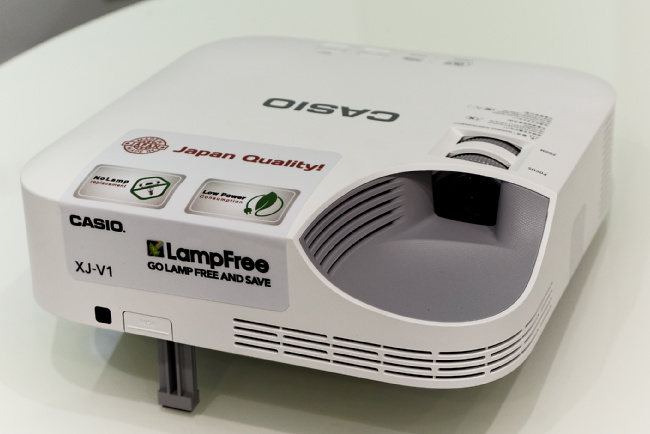
D3 is from Korea and makes interactive displays and touch tables. It has products up to 98″ (from 60″) in UltraHD. It uses infrared touch for interactivity and can support up to 20 touch points. The demo that we had used the logo on the display as a kind of “home” key and the company has worked hard to allow the use of the touch facilities of the display as the “OSD” for the display. For example, the inputs can be selected using the touch system. The OSD exploits the integrated quad core processor which runs Android. As well as the logo switch, extra buttons can be fitted to the sides of the display to allow easy access to applications. There are options also for Intel processors up to Core i7 to allow the use of Windows. The company told us that many users are not so keen on using menus and software to make changes such as line width and colour, so the company has developed a special pen with sliders and switches which allows the direct selection of these attributes. Unfortunately, the pen wasn’t working well when we were on the booth. D2 has some distribution in the region and has OEM business in Europe. It is interested in wider distribution in Europe.
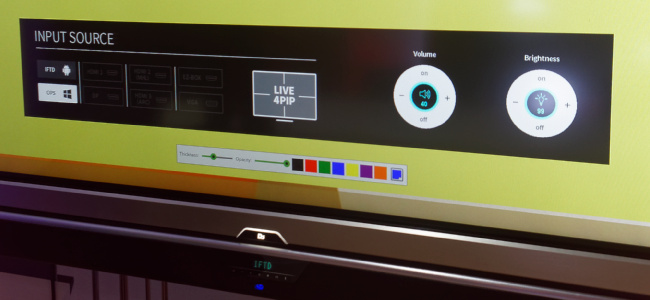 D3 uses the integrated touch for control of its OSD
D3 uses the integrated touch for control of its OSD
Delta of Taiwan highlighted its latest laser-based DLP cubes which are available in 50″ and 70″ diagonals and which are claimed to be the slimmest in the market at 450mm. The cubes can be maintained from the front or the rear and there is a redundant PSU system for improved reliability. The company told us that the colour performance of the cubes is auto calibrated.
Displax, which we covered at the TGM show event last year, is from Braga (near Porto) in Portugal and makes touch film based on metal mesh technology for large displays. At Infocomm, the company was showing an 84″ display with an optically-bonded front panel using procap technology. The display supports 100 touch points and is claimed to have a response time of 5ms. The company can apply its films to work on glass from 4mm to 15mm thickness and can work with tempered or Gorilla glass. The company makes its own controller electronics and can detect pressure, by looking at the area of the touch point. It can make film to support displays up to 100″. The company also develops its own software, so as well as supporting USB with multitouch, it can support Mac system (using one touch) and can also support mouse emulation, which has allowed operation when many other touch systems won’t work.
Elivision is from Korea and makes custom displays. At Gitex, the company was highlighting the displays that it has with automatic height adjustment. They detect the face of the user and can move up and down. We initially thought that this was something of a gimmick, but the firm outlined two clear and useful applications. The first is in drive-through QSRs, where the driver could be at a wide range of different heights depending on the vehicle. The second application is use by those in wheelchairs who may may need a much lower display surface. (It seemed to us that the base protruded quite a lot which might work against this application, but the firm seemed confident). The firm claims patents on the concept and can supply displays up to 84″.
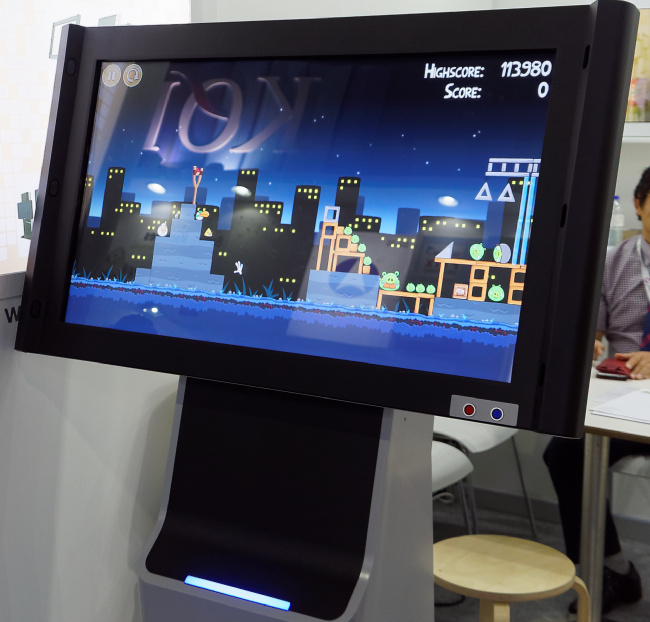 Elivison told us it has a patent on the auto height monitor which has applications in QSRs and hospitals
Elivison told us it has a patent on the auto height monitor which has applications in QSRs and hospitals
Epson did not have a lot in new products and was showing the comparison of LCD and an “out of box” DLP projector to try to highlight the better performance of 3LCD. The firm told us that it would have some interesting announcements about UltraHD at ISE in February. In the Middle East, the firm does well, especially with UST products in education. However, it feels that the consumer market in the region would benefit from development. There is a feeling that the home cinema category is really just about image size in the region and would benefit from a move to emphasize image quality.
GoGet is a Swedish company that was at the show to offer its meeting room displays which are available in 7″ and 10″ with touch facilities. The displays also run the firm’s reservation software which can integrate with Google and Exchange back ends. The 7″ is wireless only, while the 10″ also has ethernet. The industrial design was created by GoGet.
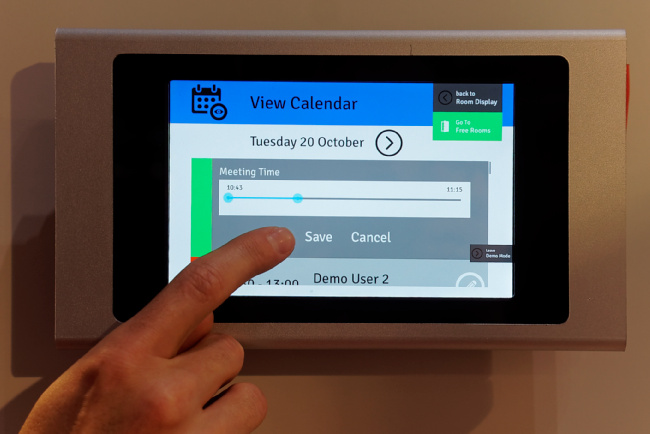 GoGet has its own displays for its room booking system
GoGet has its own displays for its room booking system
HTP of China is a leading supplier of projectors based on DLP engines and including LED light sources as well as having access to 3LCD technology. It told us that it has 20-30 models and is especially strong in the home cinema markets in the US and in China. On display was a 100″ projection system using a UST engine.
Osborne Technologies told us that its Legamaster interactive displays from the Netherlands are being sold by the graphics company, Edding, in Europe. The company was showing an 84″ UltraHD system at Gitex that supports ten point touch and is mostly used in education. The company has its own “TangoTeach” software. (At the time, we thought the Legamaster name was familiar – we originally reported on the company back in 2010, when the company was working with BenQ).
LED specialist, Leyard, had the 1.25mm LEDs we saw at Infocomm and IBC, but in a smaller arrangement. At IBC, the company told us that its 0.9mm LEDs would be in mass production by the end of 2015, but now the dates is “early 2016”. At Gitex, the firm was highlighting how the large (54″) cabinet that it uses makes set up quicker and easier. It was also showing the TVH series which has a smaller cabinet which is used in applications such as curved displays and in broadcast. The firm told us that the Planar acquisition had been the source of many questions and discussions, but will not be completed until November.
One of the number of LED display makers from China at the show was Shenzen Lightlink. The company told us that it is especially targeting rental and staging applications (it claims to be in the top 3 brands in China for this segment) and can supply product for indoor and outdoor use at 1.2mm to 25mm pitch. The cabinets that the firm designs are intended to be as light and easy to handle as possible and the company claims that the displays can be assembled at a rate of 1 m2 per minute, even with just one person. Each module has a “Quicklock” mechanism that allows very rapid alignment. Each cabinet weighs just 6.5Kg.
 Matrox showed the echoed output of its UltraHD video wall controller
Matrox showed the echoed output of its UltraHD video wall controller
Rob Moodey of Matrox showed us the latest version of the company’s MuraIPX UltraHD video wall controller card system. There are two versions of the card, one with input only and the other with input and output. This changes the way that display walls can be used. The output stream can be used for a number of purposes. At a simple level, the output can be used for monitoring the video stream. The stream can also be windowed or scaled down to FullHD which could, for example, allow monitoring of different parts of the display stream. The stream can also be recorded for audit or reporting purposes, effectively showing “proof of play out”, Moodey told us. As he said, the extra output means that the display is not the only end point.
Mediatek was at the show to promote its brand. It was showing mainly mobile phones from its customers. A technology demonstration was being made of a heart rate meter that uses the very subtle colour change in user’s face colour when the heart beats in combination with a camera to measure the heart rate of the user. Unfortunately, trade show gremlins were causing the demo to fail when we went by. However, the software will be made available to Mediatek’s customers. The company was also highlighting its 120Hz video capture “super slow motion” technology.
 Mediatek’s HRM seems to show that the engineer is dead!
Mediatek’s HRM seems to show that the engineer is dead!
 It was at Gitex a couple of years ago that we first heard that Mitsubishi had embarked on a dramatic restructuring of its display business which now focuses on control rooms. At Gitex, Alastair Duthie, a veteran of the company, told us that was showing three levels of control system displays. At the top of the range is the high end DLP cube system, which uses 6D control to adjust image quality. Further down the range, the midrange 60″ FullHD cube uses overscan to reduce the cost of the optics. Duthie told us that when the technology was introduced, he was worried that very fine (single pixel) detail might be lost, but this has not been the case. The lower cost solutions have proved popular in security installations in particular which has been a rapidly growing segment. At the low end, in terms of performance, Duthie showed us the LM55P2 55″ narrow bezel LCD monitor.
It was at Gitex a couple of years ago that we first heard that Mitsubishi had embarked on a dramatic restructuring of its display business which now focuses on control rooms. At Gitex, Alastair Duthie, a veteran of the company, told us that was showing three levels of control system displays. At the top of the range is the high end DLP cube system, which uses 6D control to adjust image quality. Further down the range, the midrange 60″ FullHD cube uses overscan to reduce the cost of the optics. Duthie told us that when the technology was introduced, he was worried that very fine (single pixel) detail might be lost, but this has not been the case. The lower cost solutions have proved popular in security installations in particular which has been a rapidly growing segment. At the low end, in terms of performance, Duthie showed us the LM55P2 55″ narrow bezel LCD monitor.
LED specialist, Nanolumens, had a very good looking 1.87mm LED display that is rated to run at up to 1,400cd/m². The display was very well aligned and we could only see one very slight horizontal edge. The company claims that its systems support 30% or 40% less power consumption than products from its competitors. It told us that it is very conservative in its ratings and offers a six year warranty down to the individual LED level. The company also highlighted its green credentials and said that 80% of its materials are recyclable.
NCS is a Japanese company that specialises in high end servers for broadcast and A/V applications. At Gitex, the company was showing its first 8K server, designed for content creators and which can store up to 30 minutes of uncompressed video at 8K – which takes 46 TB of data. The company’s aim is to be able to support up to 2 hours of 8K video, so it is also looking at very light compression (e.g. Tico/DisplayStream) to support this functionality.
NEC Display Solutions had a space on the NEC corporate booth and was showing interactive displays, digital signage and a small number of desktop monitors. There were no new products for us, but there were demonstrations of the Shadowsense-based touch systems and the high end 98″ displays. NEC is involved in a number of vertical markets in the region including corporate, higher education, retail and broadcast is proving interesting. Demonstrations included Hiperwall software and the WXGA laser projection system, which was shown using a laser curtain touch system.
ODHitec of Korea had an unusual dual-layer display system that mounts a transparent LCD on top of a standard LCD to give a display with true (but limited) depth. We couldn’t get much information on the system, but it reminded us of the development of the system by PureDepth (Deep Video). We have been reporting on systems using multiple LCDs and OLEDs since 2001 (including licenses by Samsung and LG.Philips LCD) but nobody has turned the concept into a really successful product)
PKLNS is a Korean company that specializes in eLearning. The company was showing its “digital podium” which uses dual screen so that educators can have a control surface as well as an “echo” of the main display that students see. The company develops hardware and software and has its own controller technology. It has also LCD-based touch systems which use a combination of optical and infrared technology. The sizes are 55″ (Samsung panel), 65″ (AUO), 70″ (Samsung) and 84″ UltraHD (LG). The system can include an i5-based mini PC and has a camera. The logo acts as a kind of “home” key and the company is selling the system in the UK and Italy, Asia, South Africa and the Middle East. However, the company also welcomes new distribution partners in Europe.
We were wandering past the Polycom booth and we noticed an impressive video conferencing system and we dropped in. The system uses three UltraHD displays, supplied by Polycom, but using LG panels and assembled by Orion, to support a “virtual presence” system. Multiple people could be clearly seen in high resolution on the demonstration.
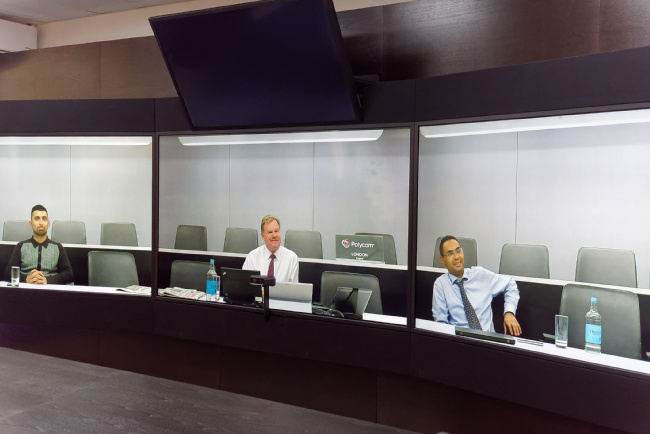 Polycom used triple UHD displays for conferencing
Polycom used triple UHD displays for conferencing
We also looked at the Network Room Compositor (NRC 200) which was being used with a 6000 Ansi lumen LP projector, the PGWU62-L and a Screen Innovation Black Diamond projection screen. 8 HD sources can be connected to the system including “2 x 4K DVI” inputs. PGWU62-L
We were somewhat frustrated by Ouigo of Taiwan. The company was showing a tempered glass-based projection screen that can be used with a projector to create a TV system of 100″ or more. The cost of the glass system, which has a gain of 0.8, is $5,000 FOB Taiwan. The glass panel, which is said to have very fine conductor elements (said to be a “crystal lattice”) helped to suppress ambient light and gave good colours and contrast. A second version was shown with rear projection, but which showed good image quality on both the front and the back of the screen. We kept asking questions to try to understand what the firm is doing, but, eventually, the company said “it’s a secret”. It would have saved us some time if it had said this first! http://www.ouigo.com.tw The concept seemed to be something close to that shown by Microlite at Infocomm (http://tinyurl.com/ow6btmd)
 The Ouigo display had good colours but didn’t seem very sharp to us
The Ouigo display had good colours but didn’t seem very sharp to us
Philips‘ Digital Signage group was at Infocomm – but the monitor and client side of the TPV/MMD business was not at the show. Chris Sluys who runs the European and North American signage business, showed us a new 49″ 3.5mm ultra narrow bezel monitor that will be shipping from January and will run alongside the company’s current 55″ model. Philips has had some success in the UAE and recently won a project for the Vox Cinema in the Mall of the Emirates. In Europe, the company has also been successful with a project, won alongside Philips Lighting, for the Allianz Arena, home of Bayern Munich.
Prysm was showing its LPD displays in a large configuration and was also showing the more recent Cascade 65″ and 85″ LCD displays. Prysm has been pushing its business towards conferencing and collaboration and most of the demo we got on the booth was of the firm’s latest collaboration and presentation software which allows the presenter to control what is shown on the displays. The Synthesis Remote Touch Console (RTC) system uses a 23″ touch screen to mirror the content from its controller. Content can also be shared and on the booth, three users were collaborating (or disrupting each other!) on different displays. I was very aware of a slightly strange artefact looking at the LPD when I moved my eyes or blinked. This is a function of the 360Hz refresh rate and short phosphor persistence, I heard.
Prysm has an installation of a 15′ x 5′ (4.5m x 1.5m) of its LPD technology at the GEMS Wellington Academy in the Silicon Oasis area of Dubai.
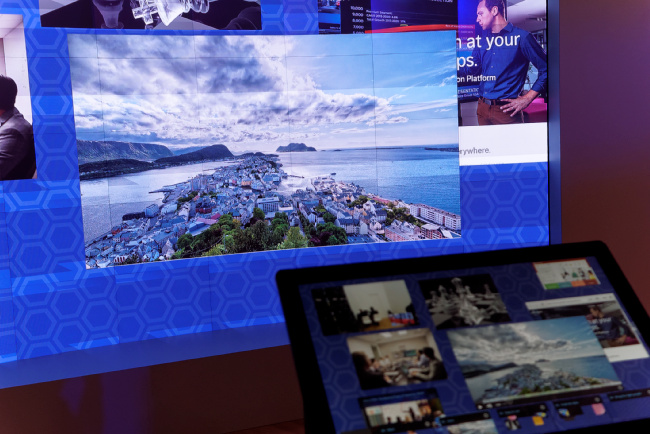
Retop was at the show with its LED displays. It was showing its 1.9mm indoor display, which has 1,000cd/m² of brightness. The company also has 1.6mm and is addressing corporate, control room and broadcasting applications. A speciality of the company is “eTotems” and the firm told us that it has supplied 2,000 or so large outdoor totems in streets and in gas stations in China. These totems produce up to 9,000 cd/m² of brightness.
Shenzen User Special Display Technologies was showing its capability of making even very small quantities of kiosk, video wall and signage displays. The company told us that it has sold $3.5 million on AliBaba in the last year. The main products are built around 46″, 47″ and 55″ panels.
Shinco used to be one of the top three brands for DVD players in China, it claimed, but as the DVD market matured, it got out of the market and re-aligned to start developing TVs from 2013 onwards. It supplies under its own brand as well as through OEMs and told us that around 30% of its sales are under its own brand, with the rest as OEM. It uses a range of panel suppliers, but tends to use AUO, LG & Samsung mainly. Sizes are from 18.5″ to 65″. The firm has done some business in Europe, but usually under private labels (such as DSG).
Silicon Core had three very impressive LED displays with pitches down to 1.2mm. The company was highlighting that it can offer front access even to its very high resolution 1.5mm LED displays. Although other companies have front access, too, Silicon Core told us that this is typically on much larger pitch products and not on the fine pitch products. Eventually, front access will be available for all the firm’s displays. The company will have a major development at the next ISE show – watch for news there.
SuperTab is from Belgium and is one of only a small group of European tablet makers. The company was showing its latest 7″ IPS LCD based tablet which features FullHD support and dual SIMs in its wireless support. The company has a special tablet developed for use by children and told us that it is selling well. It can switch from a simpler childrens mode to a full “regular” Android mode. It has the product available in a range of colours and the firm told us that it is selling well in North Africa, but the firm is relatively new to the Middle East. The company told us that, once established, it has good support from resellers as its return rate is around 1.5% – very low for a tablet.
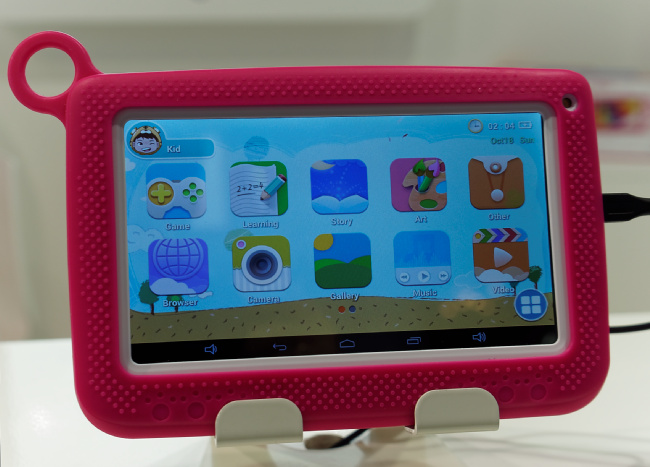
Themis is a company based in Hamburg, Germany and has a division that develops electronic shelf labels (ESLs). The company, which was at Gitex for the first time, told us that it has seen a big switch in the last year or so from a focus on LCD because of low cost, to E Ink type displays because of the improved functionality and ability to show, for example, bar codes. Another factor has been the boosting of battery lifetimes from two years to five years. The company said that its “special sauce” is not in the labels, but in the knowledge of integration of ESLs into POS systems as the firm has a lot of experience in this area. The company is also a classic German “Mittelstand” company that is privately owned. It is able to work on long term projects and can look at “step by step” implementation. For example, if a grocer has a problem or opportunity just in fresh produce, the company will work on just that department. The company also has local partners all over EMEA and subsidiaries in the UK, Spain and Slovenia. In November it will roll out a system with 30,000 E Ink – type labels in South Africa.
Triumph Board of the Czech Republic was just about the last company that we saw at Infocomm. The company specialises in interactive displays for education although it also sells into business. The main new products on show were 65″ and 84″ UltraHD interactive displays. We said that we thought that in a classroom situation, a 65″ unit with that resolution wouldn’t be too useful and the firm agreed, but it said that it has already seen tender requests for that specification. The systems from Triumph are relatively powerful and there is 10 point touch and has a built in PC with a separate graphics processor. The firm has also been developing accessories such as trolleys. It has also further developed its cloud software which can now import Smart Notebook files. The next step is to also support Google files and Triumph told us that its offer of a bundled one year licence (download) or lifetime (USB) for its software for teachers along with unlimited student accounts is proving appealing to educators.
Chinese LED maker, Unilumin, was at Gitex for the first time to “find out about the market”. The main highlight on the booth was a 1.2mm display, but the firm was also showing a 165″ FullHD 1.9mm configuration and a 138″ 1.5mm setup. Although these were being shown as “monolithic” displays, Unilumin is still basically aiming at customised displays.
Uniview is a maker of LED displays that are distributed in UAE by “Jacky’s” and was sharing the booth. It was showing a 2.5mm pitch flexible LED display. While some makers have rigid modules that can give the impression of flexibility, these units are truly flexible and the flexible backing is fixed to the frames by magnets. The company can go down to 1.6mm pitch and as 0.7mm pitch under development. Also being promoted on the Jacky’s booth was Ryham which was higlighting its LEDs for taxis and buses. These are available in a number of configurations, but the coarser pitches can can be cheaper than LCD, even though brightness is much higher. The ends of the taxi modules can either have coloured LEDs to indicate if the taxi is booked or free, or can be laminated with static advertising. Brightness can be up to 3000 nits. Uniview also had its own booth in Infocomm and was showing an LED ball which the firm can make in 1.25m, 2m or 3m diameters. The company told us that it is especially good at LED floors, which have been used at the Frankfurt motor show as they are strong enough to support the weight of a car. It has had a lot of success with 6mm LED dance floors.
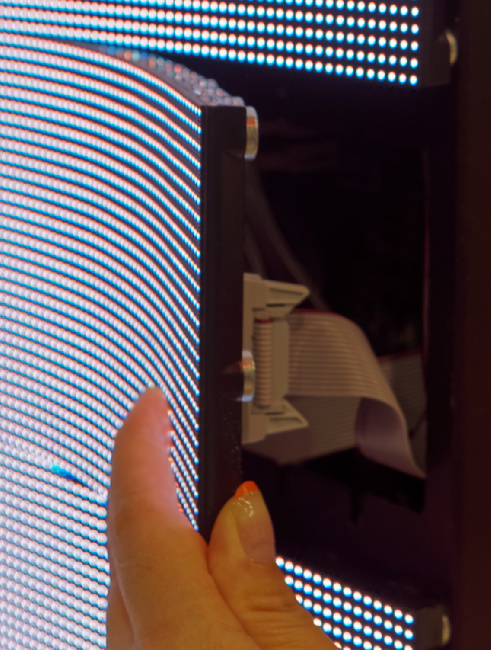
Zytronic is a UK-based developer of capacitive touch films based on metal mesh technology. The company was at the show with its Indian reseller to investigate the market. The low resistance of its foil means that it can support large sizes and its foil can support displays up to 85″ diagonal with up to 40 touch points, but using a single controller. As the company has its own production, it can be flexible, for example with logo overprints. We asked about transmissivity and were told that the mesh is so fine that the light transmission is basically the same as glass at around 90%. Although well known for large foils, Zytronic told us that 80% (or 90% the second time) of the company’s production is in 32″ and below sizes for applications such as kiosks and ATMS. The extra sensitivity of the technology is an advantage in these applications as glass up to 20mm thickness can be supported. The system uses FM techniques so is also quite stable in calibration and over time.
Zaag Technology makes standard and custom infrared overlays for touch applications. The company was showing its system, which can support up to 40 touches, on a very large video wall. It doesn’t use a modular approach, but prefers to develop fully customised solutions. It told us that there is really “no limit” to the size of the display that can be supported. Zaag has also developed a low cost whiteboard that has detectors only on the top and bottom of the screen, with nothing on the side. The system can work quickly as there are less detectors to scan and 6 touches can be supported. The company told us that the dual edged system is very stable and can be used in “any” indoor lighting.

